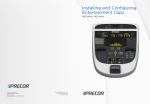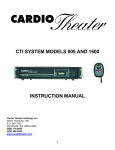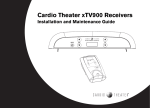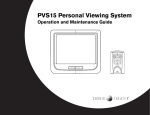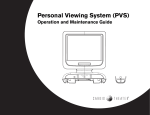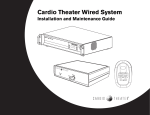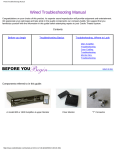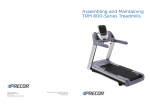Download Cardio Theater xTV900 Owner`s manual
Transcript
Cardio Theater xTV-9TM Transmitter Installation and Maintenance Guide Input POWER S ig n a l xTV8TM Trans mitter T r a n s m it t e r Channel P rogram ® Important Safety Guidelines Always follow basic safety precautions when using this equipment to reduce the chance of injury, fire, or damage. Read all instructions in this guide before installing and using the equipment. Follow any labels on the equipment. • Use the power adapter provided with the equipment. Plug the power adapter into an appropriate, grounded power outlet as marked on the equipment. • Route power cables so that they are not walked on or pinched by items placed upon or against them. • Ensure that the equipment has adequate ventilation. Do not place anything on top of or over the equipment. Do not use on a cushioned surface that could block the ventilation openings. • Keep the equipment away from water and moisture. • Locate the equipment away from sources of heat, such as radiators, heat registers, and stoves. Avoid temperature extremes. • Avoid dropping anything on or spilling anything inside the equipment, because doing so can damage the electronics. • Do not attempt to service the unit yourself except to follow the maintenance instructions found in this guide. CAUTION: DO NOT remove the cover, or you may risk injury due to electric shock. Read the Installation and Maintenance Guide before operating. There are no user-servicable parts inside. Contact Customer Support if the equipment needs servicing. For use with single phase AC supply only. Installation and Maintenance Guide: Important Safety Guidelines PRECAUCIÓN: NO quite la cubierta, ya que podría sufrir lesiones por descarga eléctrica. Antes de utilizar la unidad, lea el Manual de instalación y mantenimiento. No toque las piezas internas. Para cualquier tipo de reparación, póngase en contacto con el Servicio de atención al cliente. Utilícese únicamente con alimentación de CA monofásica. Safety Approval When identified with the ETL-C logo, the unit has been tested and conforms to the requirements of ANSI/UL 60950-1:2003 and CAN/CSA C22.2 No. 60950-1-03 Information Technology Equipment Safety, Part 1. IMPORTANT SAFETY INSTRUCTIONS • AVERTISSEMENT : NE retirez PAS le capot de l’appareil. Le retrait du capot expose l’utilisateur de l’appareil à un risque de décharge électrique. Lisez le guide d’installation et d’entretien avant toute utilisation. Cet appareil ne contient aucune pièce réparable par l’utilisateur. Contactez le service clientèle si une réparation de votre équipement est nécessaire. Utilisation avec alimentation alternative monophasée uniquement. 1 Product Recycling and Disposal This equipment must be recycled or discarded according to applicable local and national regulations. Product labels, in accordance with European Directive 2002/96/EC concerning waste electrical and electronic equipment (WEEE), determine the framework for the return and recycling of used equipment as applicable throughout the European Union. The WEEE label indicates that the product is not to be thrown away, but rather reclaimed upon end of life per this Directive. In accordance with the European WEEE Directive, electrical and electronic equipment (EEE) is to be collected separately and to be reused, recycled, or recovered at end of life. Users of EEE with the WEEE label per Annex IV of the WEEE Directive must not dispose of end of life EEE as unsorted municipal waste, but use the collection framework available to customers for the return, recycling, and recovery of WEEE. Customer participation is important to minimize any potential effects of EEE on the environment and human health due to the potential presence of hazardous substances in EEE. For proper collection and treatment, refer to Obtaining Service. Regulatory Information The Cardio Theater xTV-9TM Transmitter has been tested and found to comply with the limits pursuant to Part 15 C of CFR 47, FCC Rules. These limits are designed to provide reasonable protection against harmful interference when operated in a residential installation. This equipment generates, uses, and can radiate radio frequency energy and, if not installed and used in accordance with the owner’s manual instructions, may cause harmful interference to radio communications. FCC rules, changes or modifications not WARNING Per expressly approved by the manufacturer could void the user’s authority to operate the equipment. Industry Canada Compliance Statement This device complies with RSS-210 of the Spectrum Management & Telecommunications Radio Standards Specification. Operation is subject to the following two conditions: (1) this device may not cause harmful interference, and (2) this device must accept any interference received, including interference that may cause undesired operation. This device has been designed to operate with the antenna provided having a maximum gain of 2.14 dbi gain. Antennas not included or having a gain greater than 2.14 dbi are strictly prohibited for use with this device. The required antenna impedance is 75 ohms. FCC Compliance Statement This device complies with Part 15 of the FCC Rules. Operation is subject to the following two conditions: (1) this device may not cause harmful interference, and (2) this device must accept any interference received, including interference that may cause undesired operation. Installation and Maintenance Guide: Important Safety Guidelines 2 Table of Contents Important Safety Guidelines .................................................1 Safety Approval ............................................................................... 1 Product Recycling and Disposal ................................................. 2 Regulatory Information .................................................................. 2 Before You Begin .....................................................................4 Obtaining Service ........................................................................... 4 Preparations ..............................................................................5 Unpacking the Equipment ............................................................ 5 Required Tools and Equipment ................................................... 5 Installation Requirements .............................................................. 6 Programming the Transmitter ............................................ 10 Connecting Audio to the Transmitter ............................... 11 Maintaining and Troubleshooting ..................................... 12 Cleaning the Transmitter .............................................................12 Adding or Replacing Channel Cards .......................................12 Troubleshooting the Transmitter ...............................................13 Limited Warranty .................................................................... 15 Installing the Transmitter .......................................................9 Installation and Maintenance Guide: Table of Contents 3 Before You Begin With the Cardio Theater® xTV wireless system, fitness facilities can add entertainment to exercise rooms without the high cabling costs usually associated with entertainment systems. The xTV wireless system gives people the choice of listening to music, radio, or programs shown on TVs while they exercise. The person simply plugs a stereo headphone into a receiver, selects the desired entertainment, and exercises while listening to high-fidelity sound. An xTV wireless system consists of one multi-channel xTV-9TM Transmitter and a number of xTV900 Receivers installed on exercise equipment throughout the room. The xTV-9TM Transmitter may contain up to 12 channel cards, allowing facilities to connect up to 12 components to support a wide variety of entertainment options. Preconfigured programming modes allow facilities to assign each component its own frequency to ensure clear transmission while avoiding any frequencies that may already be used in the area. This guide explains how to install and maintain an xTV-9TM Transmitter. For proper installation, please read this guide thoroughly and follow the instructions. Note: For information about the xTV900 Receivers, refer to the xTV900 Receivers Installation and Maintenance Guide. Installation and Maintenance Guide: Before You Begin Obtaining Service Do not attempt to service the xTV-9TM Transmitter except as described in this guide. For information about product operation or service, contact an authorized Cardio Theater Technical Support Representative at 1-800-776-6695 or [email protected]. Representatives are available to serve you from 6:00 to 5:00 pm, Monday through Friday, U.S.A. Pacific Time. Returning Equipment to Cardio Theater To return equipment to Cardio Theater for any reason, you must contact Cardio Theater Technical Support and obtain a Return Authorization Number (RMA). When requesting the RMA number, explain why you are returning the equipment, for example you ordered too many receivers and the extra receiver can be returned to stock, or the equipment needs repairs. Important: Equipment must be shipped with an RMA number in order for Cardio Theater to process it. Any equipment received without an RMA number will be returned to the sender. 4 Preparations Remember to read and follow the instructions in this guide. If you do not install the xTV-9TM Transmitter according to these instructions, you could void the Limited Warranty. Unpacking the Equipment The transmitter is shipped with the following items: • One xTV-9TM Transmitter with 4 channel cards standard: an additional 8 channel cards may be installed for a total of 12 cards • To connect transmitter to antenna, 25 feet (8 meters) RG-58 coax cable with BNC connectors on both ends • These installation instructions If any items are missing, contact the dealer from whom you purchased the equipment or contact Cardio Theater Technical Support. Note: For information about the xTV900 Receivers, refer to the xTV900 Receivers Installation and Maintenance Guide. Required Tools and Equipment Obtain the following before installation: • To connect audio components, RCA audio cable, one per component Input POWER S ig n a l xTV8TM Trans mitter T r a n s m it t e r Channel • AC power cord P rogram • Phillips-head screwdriver • Fastening hardware as appropriate to secure antenna assembly to nearby wall • Antenna assembly Installation and Maintenance Guide: Preparations 5 Installation Requirements Review the following requirements before installation: • To ensure the best range and audio quality, select a location without any major internal obstructions, such as metal support posts, between the transmitter’s antenna and receivers installed on the exercise equipment. The antenna and receivers should also be installed so they are within 150 feet (50 meters) of each other and are in direct line of sight. • The xTV-9TM has four programming modes to support different situations and countries. Each mode has different frequencies assigned to its channels. Refer to the following tables to identify the mode appropriate for your installation. Table 1: Mode 1, U.S. LCS (Cardio), 52 channels Channel Frequency Channel Frequency Channel Frequency 1 905.40 19 909.80 37 919.00 2 907.40 20 912.00 38 921.00 3 909.00 21 913.00 39 922.80 • Cardio Theater recommends that you group audio components together to minimize cabling. You can install the transmitter in a rack with other audio components if desired. 4 910.40 22 913.80 40 924.40 7 914.20 25 • If the audio components are stacked in a cabinet, make sure the equipment has adequate ventilation to avoid overheating. 8 915.40 26 9 916.20 27 924.40 45 903.60 • Install the antenna nearby so it is vertical. Do not install the antenna so it is mounted horizontally, which will decrease its transmission range. In addition, the antenna should not touch or come near other transmitting antennas or metal objects. Be sure to route cabling and power cords away from the antenna, so they do not cause interference. 10 917.40 28 926.20 46 904.40 • You can mount the antenna up to 25 feet (8 meters) from the transmitter. A coax cable (RG-58 or RG-8) connects the antenna to the transmitter and eliminates any interference issues between these two components. Using a higher quality (lower loss) cable will allow a greater distance between the transmitter and antenna. 5 911.20 23 915.00 41 910.80 6 912.60 24 916.60 42 911.60 922.00 43 913.40 923.60 44 914.60 11 918.00 29 920.60 47 905.80 12 919.40 30 921.60 48 907.00 13 920.20 31 923.20 49 904.00 14 922.40 32 925.80 50 905.00 15 924.00 33 915.80 51 907.80 16 925.00 34 917.00 52 909.40 17 906.40 35 918.40 18 908.40 36 919.80 • Each audio component connected to the transmitter requires a unique channel number. Channel numbers on a transmitter determine frequencies. There is no correlation between channel numbers on a transmitter and channel numbers shown on receivers when they are programmed. Installation and Maintenance Guide: Preparations 6 Table 2: Mode 3, xTV U.S., 32 channels Table 3: Mode 2, Australia LCS (Cardio), 24 channels Channel Frequency 1 905.00 19 907.60 1 916.20 13 920.60 2 906.20 20 908.80 2 917.40 14 921.60 3 923.60 21 910.00 3 918.00 15 923.20 4 924.40 22 911.20 4 919.40 16 925.80 5 925.60 23 912.40 5 920.20 17 915.80 6 910.60 24 913.80 6 922.40 18 917.00 7 911.80 25 915.00 7 924.00 19 918.40 8 913.40 26 916.20 8 925.00 20 919.80 9 914.20 27 917.40 9 922.00 21 919.00 10 915.40 28 918.40 10 923.60 22 921.00 11 917.00 29 919.60 11 924.40 23 922.80 12 917.80 30 921.00 12 926.20 24 925.40 13 919.00 31 921.80 14 920.60 32 923.00 15 921.40 16 922.60 17 905.60 18 906.60 Channel Frequency Channel Frequency Channel Frequency Table 4: Mode 4, Australia xTV, 16 channels Channel Frequency Channel Frequency 1 923.60 9 922.60 2 924.40 10 916.20 3 925.60 11 917.40 4 917.00 12 918.40 5 917.80 13 919.60 6 919.00 14 921.00 7 920.60 15 921.80 8 921.40 16 923.00 • If you discover that some of the 900 MHz frequencies (see Tables 1–4) are used by outside non-controllable sources, you can set the transmitter to avoid those frequencies. However, this will reduce the number of channels available for you to use when installing transmitters. If the outside non-controllable source generates a powerful signal, it may also cause static interference with the wireless system, reducing audio quality. Installation and Maintenance Guide: Preparations 7 • The transmitter uses Automatic Level Control (ALC) circuitry to provide consistent sound levels to people using the receivers. With this feature, once the sound level on TVs and other audio components have been adjusted, the wireless system should not experience sound fluctuations, which have been inherent in other types of entertainment systems. To support this feature, the sound level from the connected TV and audio components must be set to a reasonable, median level. If the incoming sound level is set too low, people may hear an excessive amount of background noise while using the receivers. If the incoming sound level is set too high, it may sound distorted through the receivers. • To avoid confusion with people using the wireless system, you want receivers to logically select TV and audio components based on their placement. So, on the receiver, channel 1 would select the first TV, channel 2 would select the second TV, and so on. To support this logical usage, connect components to the transmitter in channel order. The following explains how receivers assign channels numerically. The receiver automatically searches the area for active transmitter channels and stores them in memory. It then assigns them to channel numbers, starting with the lowest transmitting channel to the highest transmitting channel, regardless of which channels are used. For example, an installation has an xTV-9TM Transmitter with assigned channel numbers 2, 4, 6, and 8; they are installed in that order from left to right. The receiver has found these transmitted channels and assigned them to a sequence of channel numbers that it displays as 1 through 4. See Table 5. Table 5: Sample installation with showing correct channel order Transmitter Channels (Installed in Channel Order) Receiver Assigns to Channel Number that People Use to Select Entertainment 1 2 1 3 4 2 5 6 3 7 8 Installation and Maintenance Guide: Preparations 4 8 Installing the Transmitter 1. Determine where you will install the transmitter and antenna. An RG-58 or RG-8 coax cable connects the antenna to the transmitter. Junction You can mount the antenna up to 25 feet (8 meters) from the transmitter: using a higher quality (lower loss) cable will allow a greater distance between the antenna and transmitter. If possible, locate the antenna where its signals will have no obstructions (such as metal support posts) to the receivers installed on the exercise equipment. In addition, the distance between receivers and antenna should not exceed 150 feet (50 meters). 2. Place the transmitter where it will operate. Make sure that it is located in a well-ventilated area with both the front and back easily accessible. You can set the transmitter on a shelf or install it in a rack with other components. 3. Install the antenna assembly in a vertical configuration. Typically, the antenna assembly is installed on a wall near the transmitter. The fastening hardware needed to install the assembly depends on the wall, and must be provided by the installer. Be sure to mount the antenna assembly away from sources that will cause static interference, such as cables, other antennae, and metal objects. Antenna assembly Mounting bracket Wall 4. Once the antenna assembly is mounted to the wall, adjust the orientation of the antenna so it points toward the receivers. The bracket can be rotated 180 degrees. Doing this helps to ensure better transmission quality to the receivers. 5. After adjusting the orientation of the antenna, secure the bracket placement by tightening the two screws in the bracket junction with the Phillips-head screwdriver. 6. Connect the coax cable with the BNC connectors on both ends to the antenna, and then connect it to the transmitter. Make sure the placement of the coax cable does not cause a problem for people or other equipment. 7. Plug the AC power cord, packaged with the transmitter, into the back of the transmitter. 8. Plug the AC power cord into a nearby power outlet. 9. Clamp the provided ferrite filter onto the antenna coax cable in close proximity to the transmitter. Installation and Maintenance Guide: Installing the Transmitter 9 Programming the Transmitter 1. Determine the channel number you want to assign to each card in the transmitter. Each card requires a unique channel number. Assign channels in sequential order to make the wireless system easier to use. See Table 6. Note: Table 6 provides blank columns that installing technicians can use to note setup information. Consider providing a brief description of what entertainment each transmitter channel provides (or is connected to) and indicate the associated receiver channel that gets assigned. Different channel numbers will provide better reception based on whether or not other equipment in the facility are using the same frequency, or possible influences from the facility infrastructure. During installation, you may need to change the channel number based on the sound quality captured by the receivers. Table 6: Site with up to 8 components Transmitter Channel 1 2 3 4 5 6 7 8 9 10 11 12 Description of Channel (Write a brief description for your site) Receiver Channel Installation and Maintenance Guide: Programming the Transmitter 2. Enter the appropriate programming mode by pressing and holding the correct key while you turn on the transmitter. The key determines in which mode you start up the transmitter. The transmitter displays a set of numbers to confirm the mode you have selected. To start up Then, press and hold Transmitter displays U.S. LCS (Cardio) 52 channels (Mode 1) Transmitter UP 1776 U.S. xTV 32 channels (Mode 3) Channel UP 0776 Australian LCS (Cardio) 24 channels (Mode 2) Transmitter DOWN 1901 Australian xTV 16 channels (Mode 4) Channel DOWN 0901 3. Set the channel number on each card. Use the Transmitter ▲ and ▼ keys to select a card; use the Channel ▲ and ▼ keys to specify the channel number. The first two numbers on the display indicates the selected card, for example “06:07” indicates card 6. The second two numbers indicate the channel. In the example, “07” indicates channel 7. 4. When you have selected the channels for all of your cards, press the PROGRAM button to lock in your selections. The display stops blinking, the transmitter reboots, and then it returns to normal operation. 10 Connecting Audio to the Transmitter 1. Connect one end of the RCA audio cable to the TV or audio source. Observe and follow the color code of the RCA audio cable connectors. If available, connect the RCA cable to the Line Audio Output connector on the TV or audio source. The Line Audio Output connector is recommended because it always provides a consistent sound level and cannot be modified by users. 2. Connect the other end of the RCA audio cable to the transmitter. Observe and follow the color code of the RCA audio cable connectors. 6. Make sure the sound levels provided by the transmitter are consistent across all channels. Plug headphones into a wireless receiver, then move through the channels, listening to the sound level and checking for disturbing or noticeable differences as you switch channels. If necessary, match the sound level provided by each TV and audio component by making slight adjustments to that component’s volume. 7. If desired, place numbered signs by each TV or audio component. People will use the number on each sign to select the desired entertainment. Important: Make sure the RCA cable is not near the power cable, or it could interfere with the audio signal. 3. If connecting to a TV, turn off its speakers using the appropriate menu function. 4. Continue connecting audio components to the transmitter following the instructions in steps 1 to 3 for each component. 5. When all the components are connected to the transmitter, check the sound quality from the transmitter using the receivers at each piece of exercise equipment around the room. If you find that a specific channel is not received well anywhere in the room, try changing the transmitter to a different channel. You may need to try several channels to improve sound quality. Some channels will be received better than others in a facility due to the infrastructure and radio frequency activity in the area. If you need to change the channel on a transmitter to improve sound quality, you will need to reprogram the receivers. Installation and Maintenance Guide: Connecting Audio to the Transmitter 11 Maintaining and Troubleshooting In general, the xTV-9TM Transmitter requires little maintenance. Refer to Cleaning the Transmitter for information. Adding or Replacing Channel Cards Over time, you may find that you want to add one or more audio components to the transmitter. Each additional audio component will need its own channel card. The xTV-9TM Transmitter can have up to 12 channel cards installed, supporting up to 12 audio components. You may also find you need to replace an existing channel card when it no longer functions correctly. This section explains how to add or replace channel cards as needed. You will need the following tools: Problems with the transmitter typically occur during installation. Otherwise, you should experience few problems once the transmitter is installed correctly. If needed, you may find the troubleshooting information in this section useful for solving any problems you experience. To add or replace a channel card you will need to open the transmitter and move the motherboard. You can then add or replace one or more channel cards as needed. • Phillips-head screwdrivers, various sizes Important: Before beginning the procedure, place the transmitter on a table with space to work, located in an ESD-approved environmentally controlled work area. And ESD grounding wristband must be worn at all times while working on the transmitter with the cover removed. 1. Make sure the power cord is unplugged. 2. Remove the screws holding the currently installed cards to the rear of the case. Cleaning the Transmitter Periodically dust the transmitter with a soft dry cloth. 3. Remove the nut and star washer holding the BNC connector to the rear of the case. Important: Do not use liquid cleaners or aerosol cleaners to clean the equipment. Do not use any solvents such as alcohol and paint thinner. CAUTION: Make sure you take appropriate anti-static precautions for the following steps. If the electronics of the transmitter are damaged, you could void the Limited Warranty. 4. Remove the top cover from the transmitter. Use a Phillips-head screwdriver to remove the 12 screws holding the top cover. 5. Inside the transmitter, remove the 8 screws holding the motherboard to the case. One screw also attaches the ground cable to the motherboard. 6. Gently slide the motherboard toward the front of the case until the BNC connector and audio connectors on the channel cards are free from the rear of the case. Installation and Maintenance Guide: Maintaining and Troubleshooting 12 7. If you plan to replace a card, gently remove that card. 8. If you plan to add one or more cards, remove the jumpers for the slots where you plan to install additional cards (see the existing card configuration for reference as needed). 9. If you plan to add one or more cards, remove the plugs associated with each slot that will be used. 10. Install the new channel card(s) into the appropriate slot(s). Make sure that the connector is fully seated. 11. Carefully slide the motherboard toward the rear of the case, fitting the BNC connector and audio connectors on the channel cards through the holes in the rear of the case. 12. Make sure the holes in the motherboard are aligned with the screw holes below, then re-install the 8 screws holding the motherboard. Be sure to re-connect the ground cable with the appropriate screw. 13. Re-install the star washer and nut holding the BNC connector to the rear of the case. 14. Insert the screws holding the channel cards to the rear of the case. Screws for new channel cards come with the card. 15. Re-install the cover with the 12 screws removed earlier. 16. Program the new channel card(s) as needed following the instructions earlier in Programming the Transmitter. Troubleshooting the Transmitter Table 7 may help you to understand and troubleshoot any problems that you encounter with the xTV-9TM Transmitter. If the suggestions in the table do not help you solve the problems that you encounter, contact Cardio Theater Technical Support. Installation and Maintenance Guide: Maintaining and Troubleshooting Table 7: How to solve most problems with transmitters Problem Static interference What to Do Single receiver Most likely problem with receiver; see Maintenance and Troubleshooting in receiver guide. All receivers • Sound level on TV or audio component may be too high. Check the equipment and adjust the sound level as needed. • Check to see if any outside sources are using the same frequency as the transmitter. Either locate and remove the outside interference, or change the card to a different channel to avoid that frequency. • Check the coax cable between the transmitter and antenna. Check the BNC connectors on the cable. • Make sure the correct mode and channel number are specified on the transmitter for that audio component. • Check the sound from audio component by connecting it to a different transmitter channel card. Listen from a receiver to see if the sound improves. • Check the transmitter channel card by connecting a working audio component to the suspect channel card. Listen from a receiver to see if the sound returns on the suspect channel card. If it returns, the problem may be with the audio component. If the sound continues poorly or not at all, then the transmitter channel card may need to be serviced. • Make sure the transmitter has power by checking the AC power cord: Is it plugged into a nearby outlet and into the transmitter? • Make sure that the antenna is upright and not located near a power cord, audio cable, or any metal objects. • If the problem continues, unplug the power cord for five minutes, then plug back in. 13 Problem Noisy sound Single receiver What to Do Problem • Make sure there are no major internal obstructions, such as metal support posts, between antenna and receiver. No sound What to Do Single receiver • Otherwise, most likely problem with receiver; see Maintenance and Troubleshooting in receiver guide. All receivers • Make sure the antenna and receivers are installed so they are within 150 feet (50 meters) of each other. • Make sure that the antenna is upright and not located near a power cord, audio cable, or any metal objects. • Otherwise, most likely problem with receiver; see Maintenance and Troubleshooting in receiver guide. All receivers • Sound on the TV or audio component may be too low or muted. Check the equipment and increase the sound or unmute as needed. • Check the sound from audio component by connecting it to a different transmitter channel card. Listen from a receiver to see if the sound improves. • Make sure the sound level of the TV or audio component connected to the transmitter is set to a reasonable, median level. • Check the transmitter channel card by connecting a working audio component to the suspect channel card. Listen from a receiver to see if the sound returns on the suspect channel card. If it returns, the problem may be with the audio component. If the sound continues poorly or not at all, then the transmitter channel card may need to be serviced. • Try changing the transmitter to a different channel to see if the sound quality improves. Some channels will be received better than others. • Make sure no other wireless transmitters are using the same channel (and frequency) at the facility. If other types of transmitters are installed, you should call Technical Support for help with determining the frequencies being used. If necessary, change the channel number on the errant transmitter. • Make sure the transmitter has power by checking the AC power cord: Is it plugged into a nearby outlet and into the transmitter? • Make sure the card to which the audio component is connected to has a channel number assigned. The card may not have been set up with a channel. A card can also be deselected by specifying “no channel.” • Check to see if any outside sources are using the same frequency as the transmitter. Either locate and remove the outside interference, or change the transmitter to a different channel to avoid that frequency. Receiver channels do not match the order of the TV and audio components; for example, channel 1 selects the second TV and channel 2 selects the first TV. Installation and Maintenance Guide: Maintaining and Troubleshooting • Make sure there are no major internal obstructions, such as metal support posts, between antenna and receiver. • Audio components were not installed in channel order. Receivers automatically assign transmitter channels to receiver channels, from lowest to highest (see Table 5). Move or reprogram the transmitter so channel numbers are in a logical sequence. You will need to reprogram receivers. 14 Limited Warranty PLEASE READ THESE WARRANTY TERMS AND CONDITIONS CAREFULLY BEFORE USING YOUR CARDIO THEATER PRODUCT. BY USING THE EQUIPMENT, YOU ARE CONSENTING TO BE BOUND BY THE FOLLOWING WARRANTY TERMS AND CONDITIONS. Limited Warranty. Precor Incorporated (“Precor”) warrants all new Cardio Theater products to be free from defects in materials and manufacture for the warranty periods set forth below. The warranty periods commence on the invoice date of the original purchase. This warranty applies only against defects discovered within the warranty period and extends only to the original purchaser of the product. Parts repaired or replaced under the terms of this warranty will be warranted for the remainder of the original warranty period only. To claim under this warranty, the buyer must notify Precor or your authorized Cardio Theater dealer within 30 days after the date of discovery of any nonconformity and make the affected product available for inspection by Precor or its service representative. Cardio Theater product deemed defective by a Cardio Theater representative, will be issued a return authorization number. Precor will not accept returns without a return authorization number. Precor reserves the right, at their option, to repair or replace the product after verification of defect. Product that fails after the warranty period expires will be repaired or replaced at the current part and labor pricing after authorization from the customer. Repairs are warranted for 90 days. Precor’s obligations under this warranty are limited as set forth below. Warranty Periods and Coverage. • Cardio Theater Transmitters xTV-T Wireless or Wired Floor Models xTVFM system transmitter • Cardio Theater Receivers XTV-R Wireless or Wired Upper Models XTVFM system receiver • Cardio Theater LCD Screen (PVS) • Cardio Theater Screen Controllers • Quick Change Headphone Jack • Optional DVD Player • CT Experience Series Screen (PVS12) • CT Experience Series Screen Controller • CT Experience Series 900 & 863 Receiver • CT Experience Series Quick Change Headphone Jack 3 Years Parts & Labor 1 Year Parts & Labor 1 Year 1 Year 90 Day 1 Year 2 Years 2 Years 2 Years 90 Days Parts & Labor Parts & Labor Parts Only Parts Parts & Labor Parts & Labor Parts & Labor Parts Only Installation and Maintenance Guide: Limited Warranty Conditions and Restrictions. This warranty is valid only in accordance with the conditions set forth below: 1. The warranty applies to the Cardio Theater product only while a. it remains in the possession of the original purchaser and proof of purchase is demonstrated, b. it has not been subjected to accident, misuse, abuse, improper service, or mechanical, electrical or non-Precor modification. c. claims are made within the warranty period. 2. This warranty does not cover damage or product failure caused by electrical wiring not in compliance with electrical codes or Precor owner’s manual specifications, or failure to provide reasonable and necessary maintenance as outlined in the owner’s manual. This warranty excludes misuse or failures of, for example, poor quality CD’s, multiple discs inserted in the player, failures caused by home-produced copies of discs, etc. 3. Except in Canada, Precor does not pay labor outside the United States. 4. Warranties outside the United States and Canada may vary. Please contact your local Dealer for details. This Limited Warranty shall not apply to: 1. Software (PROM) version upgrades. 2. Normal wear and tear, consumables and cosmetic items, including, but not limited to the following: labels. 3. Repairs performed on Cardio Theater products missing a serial number or with a serial tag that has been altered or defaced. 4. Service calls to correct installation of the product or instruct owners on how to use the product. 5. Pickup and delivery involved with repairs. 6. Any labor costs incurred beyond the applicable labor warranty period. 7. The user is cautioned that changes or modifications not expressly approved by the manufacturer of the product could void the user’s authority to operate the product. 15 Disclaimer and Release. The warranties provided herein are the exclusive warranties given by Precor and supersede any prior, contrary or additional representations, whether oral or written. ANY IMPLIED WARRANTIES, INCLUDING THE WARRANTY OF MERCHANTABILITY OR FITNESS FOR A PARTICULAR PURPOSE THAT APPLY TO ANY PARTS DESCRIBED ABOVE ARE LIMITED IN DURATION TO THE PERIODS OF EXPRESS WARRANTIES GIVEN ABOVE FOR THOSE SAME PARTS. PRECOR HEREBY DISCLAIMS AND EXCLUDES THOSE WARRANTIES THEREAFTER. Some States do not allow limitations on how long an implied warranty lasts, so the above limitation may not apply to you. PRECOR ALSO HEREBY DISCLAIMS AND EXCLUDES ALL OTHER OBLIGATIONS OR LIABILITIES, EXPRESS OR IMPLIED, ARISING BY LAW OR OTHERWISE, WITH RESPECT TO ANY NONCONFORMANCE OR DEFECT IN ANY PRODUCT, INCLUDING BUT NOT LIMITED TO: (A) ANY OBLIGATION, LIABILITY, RIGHT, CLAIM OR REMEDY IN TORT, WHETHER OR NOT ARISING FROM THE NEGLIGENCE OF PRECOR OR ITS SUPPLIERS (WHETHER ACTIVE, PASSIVE OR IMPUTED); AND (B) ANY OBLIGATION, LIABILITY, RIGHT, CLAIM OR REMEDY FOR LOSS OF OR DAMAGE TO ANY PRODUCT. This disclaimer and release shall apply even if the express warranty set forth above fails of its essential purpose. Exclusive Remedies. For any product described above that fails to conform to its warranty, Precor will provide, at their option, one of the following: (1) repair; (2) replacement; or (3) refund of the purchase price. Limited Warranty service may be obtained by contacting the authorized dealer from whom you purchased the item. Precor compensates Servicers for warranty trips within their normal service area to repair commercial product at the customer’s location. You may be charged a trip charge outside the service area. THESE SHALL BE THE SOLE AND EXCLUSIVE REMEDIES OF THE BUYER FOR ANY BREACH OF WARRANTY. EXCLUSION OF CONSEQUENTIAL AND INCIDENTAL DAMAGES. PRECOR AND/OR ITS SUPPLIERS SHALL HAVE NO OBLIGATION OR LIABILITY, WHETHER ARISING IN CONTRACT (INCLUDING WARRANTY), TORT (INCLUDING ACTIVE, PASSIVE, OR IMPUTED NEGLIGENCE AND STRICT LIABILITY), OR OTHERWISE, FOR DAMAGE TO THE PRODUCT, PROPERTY DAMAGE, LOSS OF USE, REVENUE OR PROFIT, COST OF CAPITAL, COST OF SUBSTITUTE PRODUCT, ADDITIONAL COSTS INCURRED BY BUYER (BY WAY OF CORRECTION OR OTHERWISE) OR ANY OTHER INCIDENTAL, SPECIAL, INDIRECT, OR CONSEQUENTIAL DAMAGES, WHETHER RESULTING FROM NONDELIVERY OR FROM THE USE, MISUSE OR INABILITY TO USE THE PRODUCT. This exclusion applies even if the above warranty fails of its essential purposes and regardless of whether such damages are sought for breach of warranty, breach of contract, negligence, or strict liability in tort or under any other legal theory. Some states do not allow the exclusion or limitation of incidental or consequential damages, so the above limitation may not apply to you. This warranty gives you specific legal rights, and you may also have other rights, which vary from state to state. Complete this portion and keep for your records. Purchased From: _____________________________________________________ (Dealer or store name) Phone Number: _____________________________________________________ (Dealer or store telephone number) Product/Model: _____________________________________________________ (For example: Transmitters, Receivers) Serial Number: _____________________________________________________ (The serial number is found on the shipping container or item.) Effective 30 June 2006 P/N CX30037-102 Installation and Maintenance Guide: Limited Warranty 16 ® Cardio Theater is a registered trademark, and Cardio Theater PVS and Cardio Theater Quick Change Headphone Jack are trademarks of Precor Incorporated. www.cardiotheater.com A Division of Precor Incorporated 20031 142nd Ave NE Woodinville, WA USA 98072-4002 NOTICE: Due to continuing advancements in technology, Precor Incorporated reserves the right to make changes in hardware, packaging, and any accompanying documentation without prior written notice. xTV-9TM IMG CX30422-105 Warranty Statement CX30037-102 25 March 2008




















